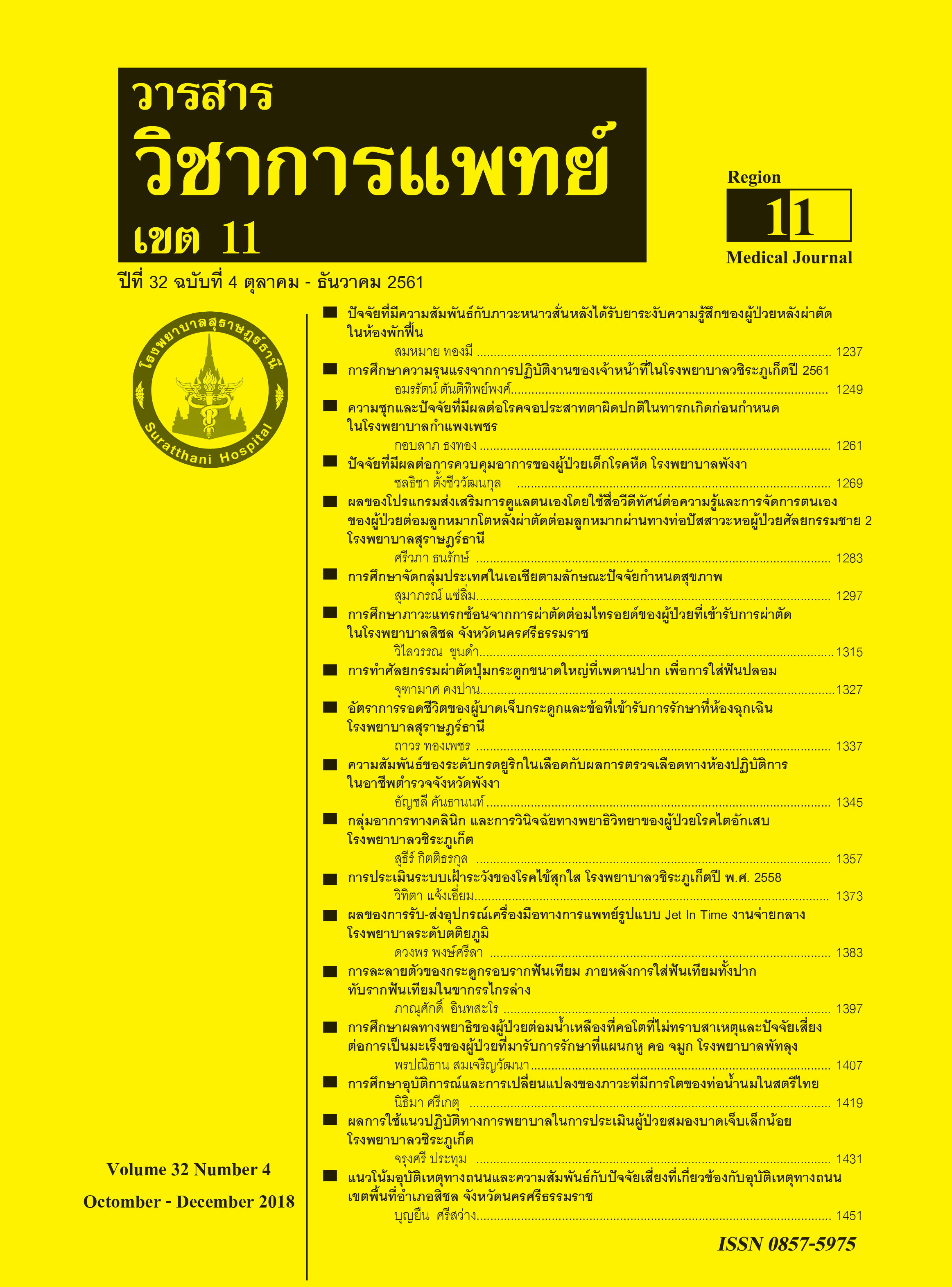Factors associated shivering of surgical patients after anesthesia in recovery room
Keywords:
shiveringAbstract
The objectives of the descriptive cross-section research were to studied shivering of surgical patients after anesthesia and factors affecting shivering of surgical patients after anesthesia in recovery room. The samples were 170 patients and the samples were selected by simple random sampling. The research instrument were anesthetic record. Data were collected during October 2016-March 2017,analyzed by computer program, descriptive statistics (percentage, mean and standard deviation) and chi-square test
The result were as follows.
The study show that in the recovery room patient undergoing general anesthesia was 52% female and 47.6% male. Age between 30-49 years was 52.9%. Age under 30 years was 39.4%. Almost the patient BMI between 18.5-24.9kg/m2 was 52.9%. BMI more than 25 was 39.4%. And BMI less than 18 kg/m2 was 7.6%. ASA class II was 61.8%. ASA class I was 38.2%. Almost patient’s body temperature before operation not more than 36.9 ํC was 48.8%. And body temperature between 37-37.4 ํC was 41.2%. Patients undergoing general anesthesia was 92.4% and undergoing general anesthesia 92.4%. And undergoing spinal anesthesia was 7.6%. The major operation was 88.2%. And minor operation was 11.8%. Operative time more than 60 min was 50%. And operative time between 61-120 min was 31.2%. Room temperature less than 22 ํC
was 57.1%. Estimated blood loss less than 100 ml was 67.4%. And estimated blood loss between 101-800 ml was 34.1%. Almost patient has administered warmed IV fluid was 66.5%. And has not used forced air warming blanket was 57.6%. All of patients in the recovery room have shivering grade 0 was 50%. And shivering grade 2 was 20.6%.
The study shows statistically significant that associative factors of shivering after operation in the recovery room were BMI less than 18.5kg/m2, major operation, operative time between 61-120 min, room temperature less than 22 ํC. Other factors such as sex, age, asa classification, body temperature before operation, type of anesthesia, estimated blood loss, warmed IV fluid and forced air warming blanket use were not associated with shivering.
According to the results, there should be developed availability of equipment (force -air warmer) and continuous research prevention shivering of surgical patients after anesthesia
References
คำเขย แสงนวล. การค้นหาสัญญาณเตือน (Triggers) ที่มีความสัมพันธ์กับ การเกิดภาวะหนาวสั่นหลังการระงับความรู้สึกทั่วร่างกาย. (ออนไลน์).2557 แหล่งที่มาจาก:URL http//www.zrolsofFt.com/HRNS/captcha ZDR/sample/oral/24-04-10 (สืบค้นเมื่อ 11 มกราคม 2560)
จันทนา คำนาค, พรพนิต ผุดเพชรแก้ว, ยุพา แก้วอ้วน และ ดรุณี จินดาสุรารักษ์. ภาวะแทรกซ้อน ทางวิสัญญีวิทยาของผู้ป่วยที่ได้รับการผ่าตัดภายใต้การได้รับยาระงับความรู้สึก แบบทั่วร่างกายระหว่างฟื้นตัวจากการระงับความรู้สึกทั่วร่างกายโรงพยาบาลแพร่ .วารสารโรงพยาบาลแพร่; 2555; 21(1): 48-57.
ทานตะวัน เกตุจำนงค์. ปัจจัยที่มีความสัมพันธ์กับการเกิดภาวะหนาวสั่นหลังการระงับความรู้สึก.(ออนไลน์). 2557. แหล่งที่มาจาก: URL http://bkh.moph.go.th/KM2016/file/r2r/57/26/262.pdf (สืบค้นเมื่อ 10 มกราคม 2560).
นงลักษณ์ เภทพ่อค้า. การรักษาการเกิดอาการหนาวสั่นด้วยการวางกระเป๋าน้ำ ำร้อนบนศีรษะร่วมกับวางบนหน้าอกในผู้ป่วยหนาวสั่นหลังการผ่าตัดในห้องพักฟื้นโรงพยาบาลมหาราชนครราชสีมา.วารสารวิทยาลัยพยาบาลบรมราชชนนีนครราชสีมา; 2554; 17 (1): 45-55
ปฏิภาณ ตุ่มทอง, วิมลลักษณ์ สนั่นศิลป์, ศิริลักษณ์ สุขสมปอง ,อังกาบ ปราการรัตน์. ตำราวิสัญญีวิทยา. เอ-พลัส พริ้น: กรุงเทพมหานคร; 2556.
รจนาถ หอมดี. ผลของโปรแกรมการให้ข้อมูลเตรียมความพร้อมอย่างมีแผนร่วมกับการใช้ผ้าห่ม แบบเป่าลมร้อนต่ออุณหภูมิของร่างกายและภาวะหนาวสั่นในผู้สูงอายุผ่าตัดเปลี่ยนข้อเข่าเทียม.
(วิทยานิพนธ์ปริญญามหาบัณฑิต,จุฬาลงกรณ์มหาวิทยาลัย); 2554.
วรภา สุวรรณาจินดา, อังกาบ ปราการรัตน์. ภัยของการให้ยาระงับความรู้สึก. พิมพ์ครั้งที่ 2. ยูลิตี้พับลิเคชั่น : กรุงเทพมหานคร; 2536
ศากุน สุริยวนากุล. ตัวแบบทำ ำนายการเกิดภาวะหนาวสั่นภายหลังการให้ยาระงับความรู้สึก ทางช่องไขสันหลังในผู้สูงอายุ. วารสารร้อยเอ็ดเวชสารโรงพยาบาลร้อยเอ็ด; 2557; 1 (1): 58-59
สาธร หมื่นสกุล. ผลของการให้โปรแกรมอบอุ่นร่างกายต่ออุณหภูมิแกนและอาการหนาวสั่นในหญิงที่มารับการผ่าตัดคลอดบุตรทางหน้าท้องที่ได้รับการระงับความรู้สึกด้วยวิธีฉีดยาชาเข้าช่องน้ำำไขสันหลัง. (วิทยานิพนธ์ปริญญามหาบัณฑิต,มหาวิทยาลัยบูรพา); 2556
สุทิวา สุริยนต์. ประสิทธิผลของการใช้แนวปฏิบัติทางคลินิคสำหรับการป้องกันภาวะอุณหภูมิกายต่ำ ำในผู้ป่วยผู้ใหญ่ที่ได้รับการผ่าตัดใหญ่และการระงับความรู้สึกทั่วร่างกายโรงพยาบาลแพร่.
(วิทยานิพนธ์ปริญญามหาบัณฑิต,มหาวิทยาลัยเชียงใหม่) . (ออนไลน์). 2555 แหล่งที่มา: http://doi.nrct.go.th/ListDoi/./4601efcea2ae9a7845d3b8df7b3cdae1?
(สืบค้นเมื่อ 10 มกราคม 2560 ).
สุพิศ สกูลคง. ปัจจัยที่มีความสัมพันธ์ต่อการเกิดภาวะอุณหภูมิกายต่ำของผู้ป่วยหลังผ่าตัดระบบทางเดินปัสสาวะในห้องพักฟื้น. วารสารเครือข่ายวิทยาลัยพยาบาลและการสาธารณสุขภาคใต้;
2559; 3(2): 195 -207
เอื้อมพร สุ่มมาตย์. ตัวแบบทำนายการเกิดภาวะหนาวสั่นภายหลังการได้รับยาระงับความรู้สึกทางช่องไขสันหลังในผู้สูงอายุ. (วิทยานิพนธ์ปริญญามหาบัณฑิต,มหาวิทยาลัยขอนแก่น); 2556
Elizabeth Read, Dr Lucy A White. Risks associated with your anesthetic section 3 : shivering. (online). 2013. Available from URL : https://www.rcoa.ac.uk
/system/files/PI- Risk3_1.pdf . (cited Febuary 19, 2017).
Hailu Tawuye Yimer*, Amare Gebreeg-zi Hailekiros and Yilkal Desta Tadesse. Magnitude and Associated Factors of Postanaesthesia Shivering Among- Patients
Who Operated Under General and Regional Anesthesia,Northwest Ethiopia: A Cross Sectional Study. (online).2015. Available from URL; https://www.omicsonline.org/.../
magnitude- and-associated-factors-of-postanaesthesia-shivering-among- patients-who-operated-unde.(cited March 25, 2017).
Zemenu Muluken. Assessment on Magnitude and Associated Factors of Post Anesthesia Shivering at Zewditu Memorial Hospital. (online). 2016.
Available from URL : http://etd.aau.edu.et/bitstream/123456789/.../ZEMENU%20MULUKEN.pdf. (cited January 7, 2017)





